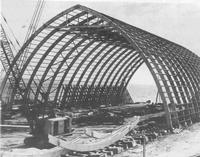


Chapter 6
I Construction During The Settlement Years
II The Use Of Timber As A Structural Material
III Structural Steel
IV Concrete Technology
V Housing
VI Industrialised Pre-cast Concrete Housing
VII Ports And Harbours
VIII Roads
IX Heavy Foundations
X Bridges
XI Sewerage
XII Water Engineering
XIII Railways
XIV Major Buildings
XV Airports
XVI Thermal Power Stations
XVII Materials Handling
XVIII Oil Industry
XIX The Snowy Mountains Scheme
XX The Sydney Opera House
XXI The Sydney Harbour Bridge
XXII Hamersley Iron
XXIII North West Shelf
Sources and References
Index
Search
Help
Contact us

The years 1920-1940 saw a period of intense development in research towards modern timber engineering technology. This research had actually commenced in the previous century, when James Mitchell had published a paper on the structural properties of Australian timbers in 1851 in the proceedings of the Royal Society of Van Diemen's land. By 1892 Professor Warren of the University of Sydney was able to report on the structural properties of 60 Australian species. Several independent research studies were then undertaken by various universities, State forestry commissions and railway authorities until 1930, when CSIR (the Council for Scientific and Industrial Research) decided to commit a major effort towards research in timber engineering through its newly formed Division of Forest Products. The CSIR attacked all aspects of timber engineering, ranging from the study of timber components such as columns, through to modern metal connector systems, the gluing of hardwoods and the pressure impregnation of timber with preservatives to enhance their durability.
The outbreak of the Second World War in 1939 generated an urgent need to use local materials for construction and thereby provided an unexpected impetus to the development of structural timber technology. One immediate effect was to stimulate CSIR into producing two milestone publications by Langland and Thomas in 1941. The first publication was a handbook of structural timber design; the second, commonly known as 'Pamphlet 112', was a set of engineered sizes for house framing. Both publications, based on the CSIR research of the 1930s, were to form the basis of all future Australian standards on the structural use of timber. In these publications two important concepts were introduced and, because of the wartime crisis, immediately accepted into building regulations. These were 'stress grading' a procedure designed to ensure the adequacy of the structural properties of full size timbers and 'strength grouping', a procedure designed to simplify the problem of dealing with multiple species.
Many remarkable timber structures were designed and constructed during the war. These included 60 metre span nailed timber arches for aircraft hangars, and 30 metre span glued laminated arches for storage buildings. The latter were probably the first successful applications for glulam in Australia (Fig. 6). These wartime structures formed a useful full scale experimental use of the newly developed timber technology. Not only did the structures include extensive usage of modern metal connector systems, but their performance also had been extended by the interim wartime application of a 20 per cent reduction of the design safety factor. In 1945 the Department of Works and Construction investigated the condition of these wartime structures and the resulting report had a major impact on subsequent timber engineering technology.

Organisations in Australian Science at Work - CSIRO Division of Forest Products
People in Bright Sparcs - Langland, I.; Leicester, Dr R. H.; Mitchell, James; Thomas, A. J.; Warren, Prof. William Henry
 |
Australian Academy of Technological Sciences and Engineering |  |
© 1988 Print Edition pages 319 - 320, Online Edition 2000
Published by Australian Science and Technology Heritage Centre, using the Web Academic Resource Publisher
http://www.austehc.unimelb.edu.au/tia/318.html